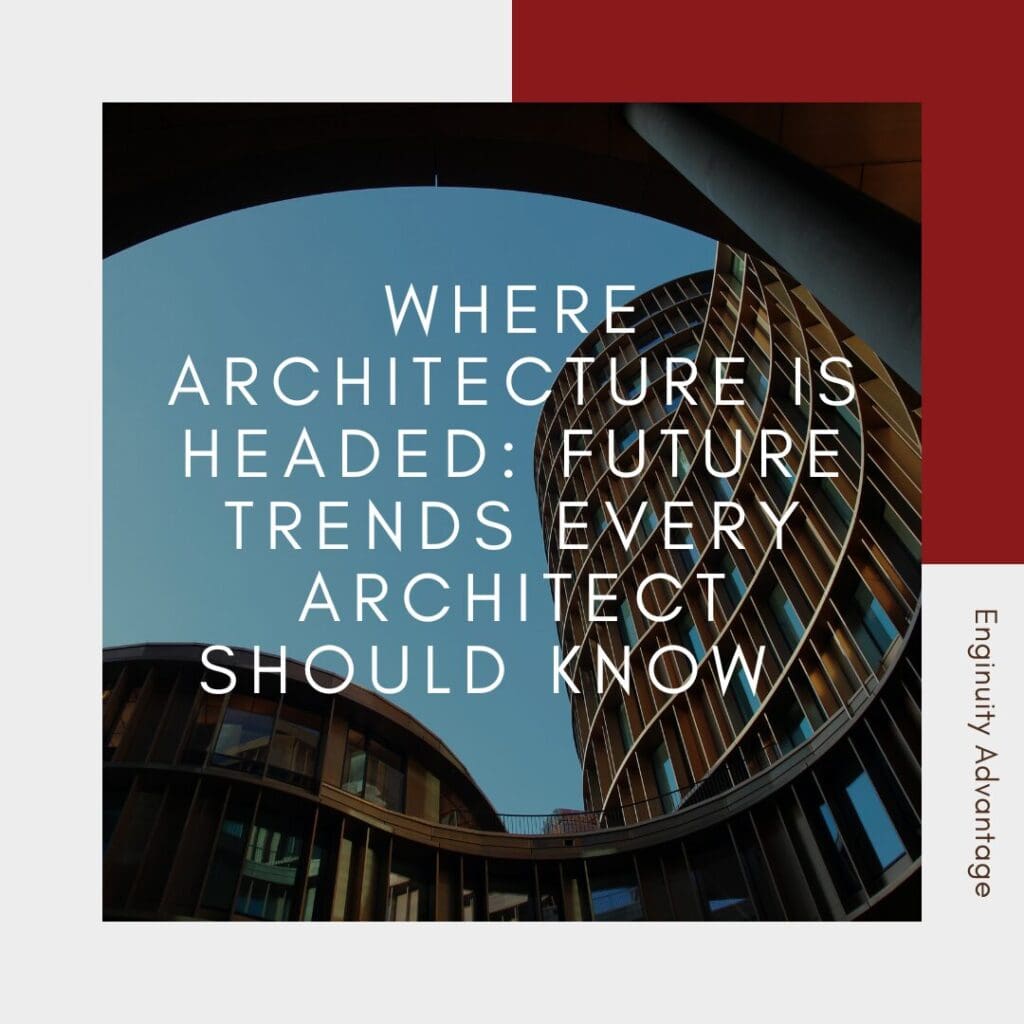Where Architecture is Headed: Future Trends Every Architect Should Know

Architecture has always been a profession rooted in balance, between form and function, between history and innovation. But as the world undergoes seismic cultural, technological, and environmental shifts, the discipline of architecture is experiencing a transformation unlike any before. This isn’t just about keeping up with change; it’s about anticipating it, embracing it, and designing spaces that reflect an evolving human experience. For architecture firms and professionals, understanding where the field is headed isn’t optional, it’s essential to thriving in the years to come.
The demands on today’s architects extend far beyond aesthetics or code compliance. They must now be strategists, collaborators, environmental stewards, and innovators. Architecture must be resilient, responsive, and deeply human. It must embrace technology without losing soul, champion sustainability without sacrificing utility, and inspire without forgetting practicality. In this new era, architectural design is being redefined through emerging tools, diverse communities, and a global consciousness of our shared future.
Designing for Environmental Integrity
Climate change is one of the most pressing challenges of our time, and architecture plays a crucial role in mitigating its effects. Design strategies have expanded far beyond energy efficiency to include regenerative principles, approaches that improve the surrounding environment rather than simply reduce harm. Architects are adopting passive solar orientation, natural ventilation, and daylighting techniques to reduce energy loads while simultaneously enhancing occupant comfort.
The use of sustainable materials is also evolving. Bamboo, cork, recycled metals, and low-carbon concrete are now considered essential ingredients in environmentally responsible construction. As the industry continues to explore carbon-neutral and carbon-negative options, materials science is intersecting with design thinking in powerful ways. Furthermore, architects are increasingly participating in cross-sector collaborations with environmental engineers and ecologists to better understand the long-term impact of their work.
Firms that focus on lifecycle assessments are able to create buildings with enduring value—spaces that are not only efficient but also adaptable and resilient. A growing number of architecture practices are turning to specialized consulting partners, including firms like Enginuity Advantage, to help build teams that understand the science behind sustainable innovation.
The Age of Integrated Technology
The digital age has ushered in tools and systems that are transforming how architects conceptualize, document, and deliver projects. BIM (Building Information Modeling) has become the backbone of many firms, offering a centralized platform for coordination across disciplines. But it doesn’t stop there. Artificial intelligence is now being used to automate repetitive design tasks and optimize building performance, allowing architects to focus more on creative and strategic aspects of the work.
In addition to BIM and AI, parametric design is unlocking entirely new formal possibilities. With this approach, architects input a set of rules and parameters, and software generates design iterations that might never have been conceived manually. This allows for faster exploration and more data-informed decision-making.
Augmented reality (AR) and virtual reality (VR) are also redefining how designers interact with clients and stakeholders. These immersive technologies make design intent clearer and improve collaboration throughout the project lifecycle. The move toward cloud-based workflows is equally significant, as it enables global teams to collaborate in real time, share models instantly, and manage large datasets with ease.
Digital literacy is becoming a fundamental skill set for architectural professionals. Architecture firms are placing greater value on candidates who can adapt to evolving technology landscapes, and many are working with industry-specific recruiters like Enginuity Advantage to find professionals who blend creative design talent with digital fluency.
The Evolution of Urban Spaces
Urban environments are undergoing a radical transformation in response to demographic shifts, economic pressures, and changing social priorities. The rise of remote work has altered the role of the central business district, prompting cities to rethink zoning, transportation, and land use. In many urban areas, planners and architects are exploring “15-minute city” models, where residents can access everything they need, workplaces, schools, parks, groceries, within a short walk or bike ride.
Affordable housing, once viewed as a separate concern from design excellence, is now part of a broader conversation about equity and urban health. Architecture is being tasked with creating dense, livable environments that don’t compromise on quality or sustainability. Public-private partnerships are increasingly common as cities seek to balance development with social benefits.
Additionally, the role of green infrastructure is expanding. Urban forests, permeable surfaces, and daylighted waterways are becoming standard features in progressive city plans. These elements not only improve ecological outcomes but also enhance mental well-being, reduce urban heat, and foster community.
Firms that aim to shape the future of cities must invest in multidisciplinary teams, designers, policy analysts, economists, and community advocates working together. Organizations like Enginuity Advantage are supporting this shift by helping firms attract diverse professionals who are as comfortable with civic dialogue as they are with design.
Putting People at the Center
Human-centered design is no longer a buzzword, it’s a requirement. Architecture today must enhance not only how spaces function, but how they feel. As health, wellness, and inclusivity become central to design thinking, architects must consider neurodiversity, mental health, mobility, and culture in every decision.
From sensory-sensitive environments to spaces that reflect diverse identities and rituals, inclusive architecture has become a marker of leadership and responsibility. Offices that support hybrid work, schools that boost emotional resilience, homes that adapt to changing family dynamics—these are the challenges defining the next era of design.
This shift requires architects who empathize deeply and think expansively. Talent that blends technical capability with emotional intelligence is now critical to team success. Firms looking to stay competitive will need recruitment partners that understand the value of this human-centric lens, and know how to find professionals who lead with it.
The Future Is Collaborative
As the complexity of architectural projects grows, so too does the need for seamless collaboration. Architects no longer work in isolation. They coordinate with engineers, technologists, contractors, city planners, and clients from ideation through execution. The ability to lead, facilitate, and adapt within diverse teams is now a cornerstone of architectural excellence.
This new era of collaboration is redefining not just how teams work—but who they include. Multi-disciplinary studios, public-private partnerships, and community-led design processes require architects to be great communicators, negotiators, and listeners.
Enginuity Advantage plays a strategic role in this collaborative evolution, helping firms source team members who thrive across disciplines and who can balance creative vision with collective problem-solving.
Education, Mentorship, and the Next Generation
To prepare for the future, architecture must also nurture it. The next generation of architects is emerging with new values, new tools, and new expectations. They seek purpose over prestige, sustainability over status, and flexibility over tradition. They expect mentorship, growth, and impact.
Firms that cultivate inclusive mentorship programs, invest in continuous learning, and promote leadership pathways from within will be the ones that not only attract top talent but retain it. The profession must evolve to support these aspirations with intention.
Enginuity Advantage continues to be a trusted partner in this evolution, working with forward-thinking firms to shape teams that are not only technically excellent but also aligned with the cultural shifts driving the future of the field.
Material Innovation and Design Ethics
A wave of material innovation is reshaping how architects build, source, and specify for the future. From self-healing concrete to carbon-absorbing bricks, new materials are no longer only functional—they are ethical tools in the architect’s arsenal. Ethical sourcing, recyclability, and the social impact of materials are now part of early-stage design thinking. Projects that fail to consider these elements risk reputational damage and long-term environmental consequences.
The growing need to evaluate not just what a material does, but where it comes from and how it affects people and ecosystems, calls for architects to be better informed and ethically grounded. Enginuity Advantage helps firms identify professionals who understand the responsibility that comes with material selection and can innovate with purpose and precision.
Globalization and Local Identity
As design becomes increasingly global, there’s a renewed call to protect and celebrate local identity. The architecture of the future must walk a delicate line, embracing global advancements while honoring the stories, customs, and climate realities of the communities being served. Architects are now tasked with designing in a way that fosters connection and respect.
Projects that succeed on a global stage will be those that seamlessly weave innovation with authenticity. This means hiring talent who understand regional vernaculars and global contexts alike—an area where Enginuity Advantage continues to support firms in building culturally aware, location-savvy teams.
Rethinking the Business of Architecture
Finally, the future of architecture depends not only on what is built, but on how firms themselves operate. Business models are evolving. Flexible work arrangements, new revenue streams, and expanded client services are changing how firms define success. Architects are becoming educators, consultants, sustainability analysts, and facilitators of community change.
Future-focused firms are embracing design as a service model and investing in internal leadership that supports agility, equity, and innovation. This means building a team that doesn’t just design buildings—but drives strategic growth. Enginuity Advantage plays a critical role in helping firms find this rare blend of design and business leadership that defines architecture’s next frontier.
Embracing the Unwritten Future
Architecture doesn’t just respond to the world, it helps shape it. And in this moment of accelerated change, the profession must act with vision, integrity, and boldness. The trends reshaping architecture, climate-conscious design, digital fluency, human-centered spaces, and multidisciplinary collaboration, are not distant concepts. They are today’s realities.
The firms that will lead this future are already adapting. They’re building teams with foresight. They’re investing in systems that support agility. And they’re partnering with experts like Enginuity Advantage to ensure that every hire moves them closer to their long-term goals.
Where architecture is headed depends on those who design it. And those who design the future must be as dynamic, inclusive, and inspired as the world they hope to build.
Unlock Dream Careers & Elite Talent: Just One Click Away!


